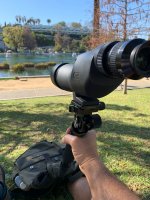We're ready to add a small spotting scope to our binoculars. Leaning toward 50mm with ED glass as we highly value light weight and small size. We have been accustomed to 32mm objectives so we think 50mm will be good as long as it's very high quality. Close focus also very important as we often observe flowers, insects, ponds near our feet. So far we've found two scopes of interest: Vortex Razor HD and Opticron mm4. The Vortex focuses to 2.5 meters vs 3.5 for the Opticron, and is less expensive, but the primitive fold-down eyecups on the Vortex seems out of place and cheap in an otherwise very nice scope. The Opticron also has the option for a fixed 13x wide angle eyepiece which would be excellent for hand-held use.
Your thoughts? Do you have any other 50mm scope recommendations?
Second question: Angled vs straight. I can see the advantage of the angled, scope can sit lower on the tripod and don't have to tilt the head and neck up to see high angles, but looking down close nearby seems like it would be harder. Also having the direction of view differ when acquiring a bird, moving back and forth between naked eye and scope might be disorienting. Any thoughts here? Much of the time we'll be using it hand-held or on a monopod.
Your thoughts? Do you have any other 50mm scope recommendations?
Second question: Angled vs straight. I can see the advantage of the angled, scope can sit lower on the tripod and don't have to tilt the head and neck up to see high angles, but looking down close nearby seems like it would be harder. Also having the direction of view differ when acquiring a bird, moving back and forth between naked eye and scope might be disorienting. Any thoughts here? Much of the time we'll be using it hand-held or on a monopod.






